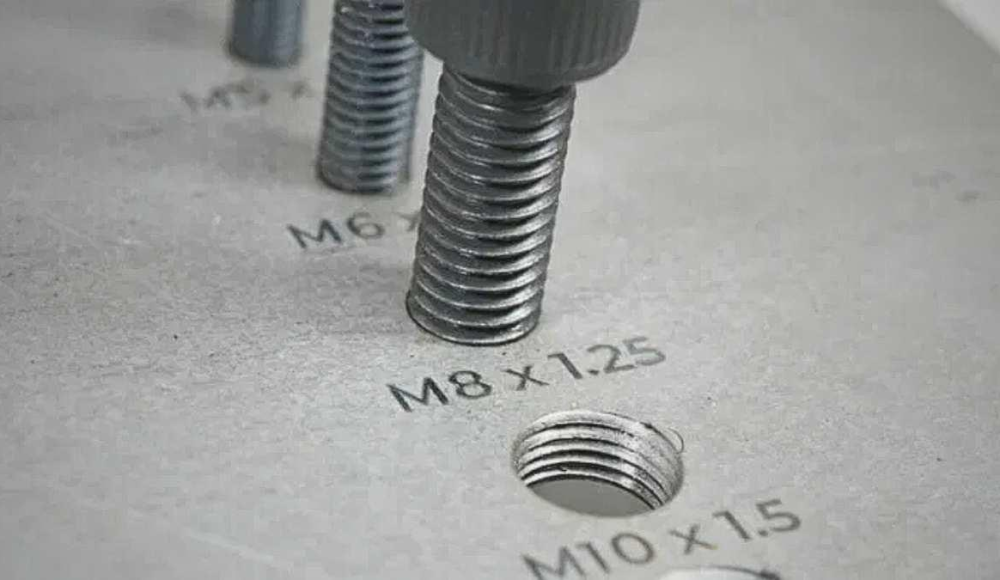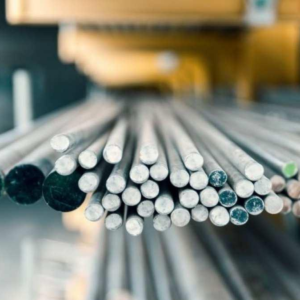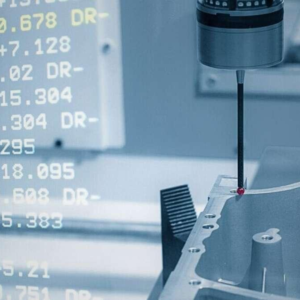Ao escolher o tipo de furo certo para um projeto, você pode ficar confuso entre furos roscados e furos roscados. Eles devem ser bem compreendidos para que o tamanho correto e a aplicação possam ser alcançados em componentes mecânicos. Ambos são úteis para funções específicas, e tipos de furo, e sua localização afeta a força, conjunto, e desempenho. Os furos roscados são feitos diretamente para serem usados com parafusos e são conhecidos como uma forma conveniente de fixação. No entanto, furos roscados geralmente são destinados a aceitar porcas ou parafusos.
Neste artigo, você descobrirá as diferenças entre furos roscados e roscados, e dicas para selecionar o tipo mais adequado para sua aplicação.
O que está tocando?
Tocando é uma técnica de usinagem na qual as roscas dos parafusos são cortadas diretamente em um furo pré-rosqueado, de modo que o furo seja feito para receber um fixador roscado ou outro hardware relacionado. Existe um instrumento conhecido como macho, normalmente equipado com canais helicoidais para cortar roscas em materiais como metal e plástico.. O tamanho nominal do furo roscado é indicado pelo tamanho do macho usado normalmente em polegadas ou milímetros. A fórmula para calcular o tamanho da broca para rosqueamento é:
Tamanho da broca = tamanho nominal − passo
Onde:
- O tamanho nominal é conhecido como o tamanho necessário do furo roscado.
- O passo determina a distância entre as roscas e geralmente depende do tipo de macho.
O Tapping pode ser feito através de diversas técnicas; escutas manuais para projetos de pequena escala ou escutas elétricas para projetos industriais de grande escala. O rosqueamento da máquina pode empregar um ciclo de rosqueamento que define uma velocidade do fuso e uma taxa de avanço para maximizar a precisão do processo.
Os fatores no rosqueamento incluem a escolha do material certo para o macho, por exemplo, o aço rápido (HSS) e carboneto, e, lubrificantes de óleo. Métodos e cálculos corretos de rosqueamento com macho são essenciais quando se trata de criar perfis de rosca corretos para garantir a estabilidade dos componentes unidos.
O que é rosqueamento?
Rosqueamento refere-se ao processo de fabricação no qual as roscas são cortadas em uma peça cilíndrica para fazer roscas externas ou internas. Permite que os componentes sejam unidos por meio de parafusos, nozes, ou parafusos, garantindo uma conexão firme e forte. O processo de rosqueamento pode ser feito cortando, rolando, ou perseguindo.
Em corte, uma máquina de torno é amplamente utilizada, onde uma ferramenta de corte é usada para remover material para criar o perfil da rosca. O tamanho nominal do componente roscado refere-se ao diâmetro e passo da rosca do componente em questão.
A fórmula para calcular o passo de um componente roscado é:
Passo = 1/Tópicos por polegada (TPI)
Onde:
- Fios por polegada (TPI) indica o número de fios dentro de uma polegada.
A laminação é outro método de rosqueamento usado na produção de um grande número de fixadores por vez.. Nesta técnica, o material é dobrado para formar fios sem a necessidade de cortar nenhum material. Assim, os fios formados são mais fortes que o material de base devido ao endurecimento por trabalho.
Threading deve levar em conta vários padrões como o Unified National Thread (E) ou os padrões Metric Thread. As ferramentas usadas, a forma do fio, e a seleção apropriada de materiais são determinantes significativos de precisão e confiabilidade em conexões roscadas.
Diferenças entre furos roscados e furos roscados
Aqui está uma tabela de comparação destacada:
| Parâmetro | Furos roscados | Furos roscados |
| Método de usinagem | Utiliza um macho para formar roscas internas por meio de ação de corte. | Emprega uma ferramenta de matriz para produzir roscas externas através da deformação do material. |
| Capacidade de carga | Geralmente menor resistência à tração, adequado para aplicações de suporte de carga moderada. | Capacidade de carga superior, projetado para ambientes de alto estresse e conexões críticas. |
| Precisão da rosca | Oferece maior precisão para roscas internas, ideal para tolerâncias restritas. | A precisão pode variar com base nas ferramentas e na calibração da máquina, afetando o envolvimento do thread. |
| Velocidade de produção | Tocar normalmente é um processo mais rápido, permitindo a rápida formação de fios. | O rosqueamento pode exigir tempos de ciclo mais longos, especialmente para aplicações de alta precisão. |
| Eficiência Operacional | Menos eficiente para fabricação em larga escala devido às trocas de ferramentas necessárias para diferentes tamanhos. | Altamente eficiente na produção em massa, particularmente com sistemas de rosqueamento automatizados capazes de lidar com vários tamanhos. |
| Escopo de aplicação | Comumente usado em aplicações que exigem fixadores removíveis, como gabinetes eletrônicos. | Preferido para conexões permanentes em componentes estruturais, montagens automotivas, e aplicações mecânicas críticas. |
Semelhanças & Limitações para furos roscados e roscados
Semelhanças
Propósito: Furos roscados e roscados são usados para unir os componentes. O que significa que ambos oferecem uma maneira de peças de fixação em estruturas mecânicas.
Engajamento do tópico: Ambos os tipos usam fixadores roscados, parafusos, ou parafusos para fluxo de carga e estabilidade de estruturas em usos de construção.
Compatibilidade de materiais: Ambos podem ser feitos em materiais como; metais, plásticos, e compósitos o que torna as aplicações diversas.
Conformidade com padrões: Os furos roscados e roscados podem estar em conformidade com padrões específicos, como o Unified National (E) ou padrões métricos ISO para manter a compatibilidade em sistemas de fixação.
Limitações
Capacidade de carga: Os furos roscados podem ter uma capacidade de carga menor do que os furos roscados, mais ainda em projetos que necessitam de alta resistência ao cisalhamento ou à tração. Além disso, as roscas não têm uma profundidade de engate profunda, portanto, muitas das roscas são produzidas rasas.
Complexidade de instalação: Os furos roscados podem exigir peças extras, como porca ou arruela. Portanto, eles podem ser mais desafiadores na montagem e desmontagem do que os furos roscados diretamente.
Precisão de usinagem: Para obter maior precisão tanto no rosqueamento quanto no rosqueamento, é preciso obter alinhamento e usinagem corretos. Escolhas de usinagem inadequadas podem causar deslizamento da rosca ou engate inadequado.
Remoção de Materiais: O rosqueamento remove o material para criar roscas que sempre comprometerão a resistência do material ao seu redor. Além disso, o rosqueamento pode resultar em deformação do material dependendo do tipo de rosca usada.
Considerações de custo: Frequentemente, a formação roscada e os furos roscados utilizam diferentes tipos de ferramentas na usinagem, portanto, ferramentas diferentes, tendem a incorrer em diferenças de custos. O rosqueamento geralmente é mais barato em comparação ao rosqueamento, especialmente para aplicações complexas. Embora o rosqueamento possa exigir equipamentos mais elaborados.
Principais conclusões
Furos roscados são um tipo específico de furo roscado no qual as roscas internas são produzidas por meio de um procedimento denominado rosqueamento. Os termos “furos roscados” e “furos roscados” são intercambiáveis.
Um furo perfurado é um furo cilíndrico, e ou cavidade que possui paredes internas polidas devido à remoção de material. Por outro lado, os furos roscados possuem roscas internas complexas que dão espaço para a fixação dos componentes.
Se você tem algum costume Necessidades de fabricação de peças CNC, Precisão máxima está pronto para ajudá-lo. Somos especialistas em usinagem de furos roscados em diversos materiais, facilitando a aquisição de diversas peças personalizadas à medida que adotamos técnicas eficientes.
Na máxima precisão, oferecemos a você a oportunidade de se concentrar na engenharia que você faz – seus projetos. Junte-se à nossa comunidade agora e envie sua parte para saber como funciona nossa ferramenta de cotação rápida, obtenha insights sobre capacidade de fabricação, e veja o que nossa poderosa plataforma pode fazer por você.
perguntas frequentes
1º trimestre. Quais materiais são mais adequados para rosqueamento e rosqueamento?
O rosqueamento é mais eficaz com materiais mais duros, como aço e alumínio, ele pode lidar bem com a força de corte. O rosqueamento pode ser feito em um tipo de material mais amplo, como metais e plásticos mais macios, dependendo da abordagem pretendida.
2º trimestre. Como escolho o tamanho de toque correto para minha aplicação?
O tamanho da torneira deve corresponder ao diâmetro nominal do parafuso ou perno que está sendo usado. Use a fórmula: Tamanho da broca=Tamanho nominal-passo para garantir o encaixe adequado da rosca.
3º trimestre. Em quais indústrias são comumente usados furos roscados e roscados?
Furos roscados versus furos roscados são usados na indústria automotiva, aeroespacial, maquinaria, indústrias de construção, indústrias eletrônicas, e indústrias médicas também. Desempenham papéis críticos na proteção dos componentes montados, bem como no suporte estrutural.
4º trimestre. Por que os furos roscados são úteis em aparelhos eletrônicos?
Os furos roscados são úteis na montagem de placas de circuito e componentes em caixas eletrônicas. Este design também facilita a instalação e desmontagem deste design, de modo que a manutenção e a atualização são relativamente mais fáceis.




1 pensei em “Furos roscados vs.. Furos roscados: Conheça a diferença”